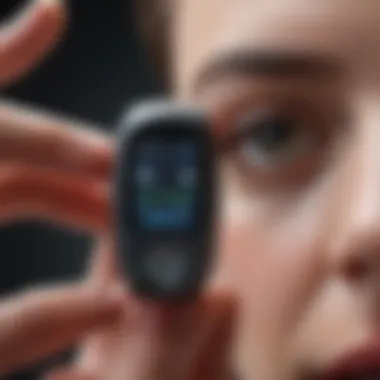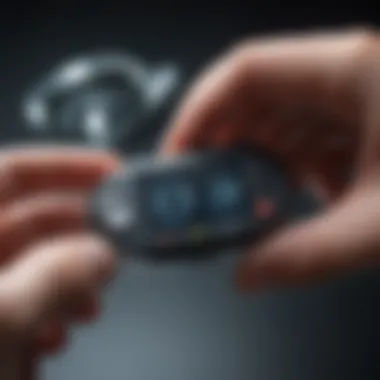Dexcom 4: Comprehensive Review of CGM Technology


Intro
Continuous glucose monitoring technology has seen remarkable progress in recent years. One major player in this field is the Dexcom 4. This device provides real-time insights into glucose levels for individuals managing diabetes. Understanding how it works, its features, and the effects it has on diabetes management is essential for both patients and healthcare professionals. This review will delve into various aspects of the Dexcom 4, illuminating its role in facilitating better glycemic control.
Overview of Research Topic
Brief Background and Context
The Dexcom 4 represents an evolution in the realm of continuous glucose monitoring. Individuals with diabetes have long struggled with the challenges of frequent finger prick tests and the unpredictability of blood glucose levels. Dexcom has changed this landscape with devices that continuously track glucose levels, providing real-time data that allows for timely decision-making.
Importance in Current Scientific Landscape
The significance of continuous glucose monitoring expands beyond mere convenience. Clinically, it allows individuals with diabetes to maintain better control over their condition. Studies have shown that CGM users often experience improved glycemic control and reduced hypoglycemic incidents. Furthermore, continuous monitoring aligns with modern healthcare goals of personalized patient care, making this topic highly relevant in today’s healthcare discussions.
Methodology
Research Design and Approach
This review utilizes a comprehensive approach, integrating both qualitative and quantitative data regarding the Dexcom 4. By reviewing clinical studies, user testimonials, and product specifications, a rounded perspective is formed. Such an inclusive methodology ensures that both technical aspects and user experiences are considered.
Data Collection Techniques
Data was collected through various channels:
- Clinical trials: Research articles analyzing the device's effectiveness.
- User feedback: Insights gathered from patient reviews on platforms like Reddit.
- Official documentation: Specifications and guidelines available through Dexcom’s official website.
In synthesizing this data, the review aims to highlight the strengths and limitations inherent to the Dexcom 4 while making it accessible to a broader audience.
"The advent of smart diabetes management tools like Dexcom 4 has redefined the patient experience, giving them new levels of control and insight into their health."
This review serves as a thorough guide to understanding the Dexcom 4 in detail, laying the groundwork for further exploration into its capabilities and implications in diabetes care.
Prelims to Continuous Glucose Monitoring
Continuous glucose monitoring (CGM) has emerged as a critical technology for individuals managing diabetes. It offers real-time insights into glucose levels, enabling users to make informed decisions regarding their health. The significance of CGM lies not only in its ability to provide constant glucose data but also in how it transforms diabetes management.
This article will explore the Dexcom 4, a notable player in the CGM space, analyzing its contributions to improved glycemic control, patient compliance, and overall welfare for users. Despite its benefits, understanding CGM technology's limitations adds essential context to its application in healthcare. Thus, investigating both advantages and challenges is key to appreciating the advancements in glucose monitoring.
Historical Context of Glucose Monitoring
Early methods of glucose monitoring primarily relied on fingerstick tests, a process that, while effective, introduced inconvenience and discomfort for patients. Tests were sporadic and lacked the comprehensive data necessary for real-time decision-making. Over time, innovations led to portable glucose meters utilizing blood samples. However, these options still imposed limitations on frequency and context of readings.
The evolution towards continuous monitoring began in the late 20th century, as researchers recognized the need for a more dynamic approach to managing diabetes. The first substantial advancements in CGM technology appeared in the early 2000s, providing a continuous stream of glucose data, which ultimately enabled more responsive and proactive healthcare strategies.
The Evolution of CGM Technology
The path from traditional monitoring to CGM has been marked by technological innovations that have enhanced accuracy and user experience. Early CGM systems were cumbersome and often difficult to interpret. However, as advancements progressed, key components such as sensor design and data transmission improved dramatically.
The introduction of subcutaneous sensors marked a significant milestone. These sensors measure glucose levels in the interstitial fluid, providing data that reflects glucose trends with minimal invasiveness. Furthermore, advancements in Bluetooth technology have transformed data sharing. Glucose readings can now be instantly transmitted to smartphones, allowing users to receive alerts regarding significant glucose fluctuations.
A notable addition to CGM technology is the mobile application integration, which enhances user engagement. Users can now track glucose levels, obtain personalized insights, and share data with healthcare providers in real time. This integration promotes a more proactive management approach and forms a critical part of diabetes care.
"The shift from reactive to proactive glucose management exemplifies a significant change in diabetes treatment strategies, underscoring the importance of continuous data access."
The technological trajectory of CGM continues to progress, but an understanding of its origins and evolution is crucial for appreciating its current capabilities and future directions.
Overview of Dexcom


Dexcom 4 stands at the forefront of continuous glucose monitoring, impactful for people managing diabetes. It encapsulates modern advancements in technology that address the persistent challenge of maintaining glycemic control. Recognizing the significance of monitoring glucose levels, Dexcom 4 demonstrates efficiencies that enhance user experience while ensuring robust clinical outcomes. This section provides a detailed examination of the technical features and user accessibility that underlie its effectiveness.
Key Technical Features
Sensor Design and Functionality
The sensor design of Dexcom 4 is crucial for its ability to consistently measure glucose levels. Featuring a thin, flexible design, it minimizes discomfort for the user. The sensor is made to remain in place for an extended period, which supports patient adherence.
A significant characteristic is its accuracy in glucose measurement, which improves the ability to tailor diabetes treatment. The sensor also employs a calibration-free design, allowing users to avoid frequent fingerstick testing, which adds to the overall convenience and appeal of the device. This innovation proves beneficial in enhancing the overall monitoring experience and improving glycemic outcomes.
Data Transmission and Connectivity
Data transmission capability is a cornerstone of the Dexcom 4 system. Using Bluetooth technology, the sensor transmits real-time glucose data to a mobile device. This enables a seamless and continuous flow of information that is critical for timely decision-making in diabetes management.
The connectivity aspect of Dexcom 4 allows for integration with wearable devices and other health technology, expanding its usability for diverse patient needs. Such integration enhances the overall monitoring ecosystem, making it a popular choice for those seeking comprehensive diabetes management solutions.
Mobile App Integration
The integration with mobile applications is another standout feature of Dexcom 4. The accompanying mobile app offers user-friendly navigation and presents glucose data in accessible formats. This design choice supports users in tracking their patterns and making informed decisions about their health.
Moreover, the app’s alert system notifies users of critical glucose levels, providing a safety net. This feature ensures that users can respond promptly to potential hypo- or hyperglycemic events, which is instrumental for safe diabetes management.
User Experience and Accessibility
Ease of Use
Ease of use is paramount for any medical technology aiming for widespread adoption. The design of Dexcom 4 emphasizes simplicity, with intuitive interfaces and minimal setup requirements. Users find that the installation process is straightforward, which can alleviate initial apprehensions about using such advanced technology.
The user manual is clear, and the app guides individuals through every necessary step, making it accessible even for those who might not have experience with similar devices. This focus on user-friendliness plays a significant role in promoting sustained use and positive outcomes.
Comfort and Wearability
Comfort and wearability are critical when evaluating glucose monitoring systems. Dexcom 4's sensor is designed to be worn discreetly, which many users appreciate. The lightweight nature of the sensor makes it nearly unnoticeable during everyday activities. This factor encourages longer wear times and contributes to consistent data collection, which is essential for effective glucose management.
Its adhesive quality also minimizes the chances of the sensor becoming dislodged during physical activities, which is an important consideration for active users.
Real-Time Data Monitoring
Real-time data monitoring is a key advantage of the Dexcom 4. The ability to receive continuous updates on glucose levels enables proactive management of diabetes. This immediacy empowers users to make swift lifestyle and dietary adjustments based on fluctuations in their glucose levels.
The continuous nature of monitoring helps users understand their body's responses to various factors, including food intake, exercise, and stress, further enhancing their overall management strategies.
"Real-time monitoring is not just about data; it’s about improving the lifestyle choices that can lead to better diabetes control."
In summary, Dexcom 4 showcases an innovative design that combines user-friendly features with cutting-edge technology. Its technical specifications and user experience attributes position it as a crucial tool for effective diabetes management.
Clinical Efficacy of Dexcom
The clinical efficacy of the Dexcom 4 device stands as a cornerstone topic for understanding its full potential in diabetes management. This section explores how this advanced technology impacts glycemic control, enhancing the quality of life for individuals with diabetes. The evidence gathered from various studies underscores the device's effectiveness in minimizing the risks associated with blood sugar fluctuations, particularly in patients who require tight glycemic control.
Impact on Glycemic Control
Reduction in Hypoglycemic Events
The reduction in hypoglycemic events is a significant aspect of Dexcom 4's clinical efficacy. This feature is vital for individuals who experience hypoglycemia, which can lead to severe complications. Dexcom 4 provides continuous monitoring, ensuring users receive real-time data regarding their glucose levels. This timely information allows for swift corrective actions, effectively lowering the incidence of hypoglycemic episodes.
One key characteristic of this reduction is the alarm system, which alerts users when blood sugar levels approach dangerous lows. This alarm serves as a crucial safety net, especially for those who may not recognize early symptoms of hypoglycemia. The unique feature of real-time notifications enhances user responsiveness, making Dexcom 4 a popular choice in diabetes management.
The advantages of reduced hypoglycemic events extend beyond immediate health safety; they also contribute to improved mental well-being and confidence in managing diabetes. However, it is essential to note that while the device significantly lowers these events, its effectiveness may vary based on user compliance and environmental factors, underscoring the need for engaged usage.


Improved A1C Levels
Improved A1C levels represent another critical benefit of utilizing Dexcom 4. A1C testing provides an average of blood glucose levels over three months, making it a vital marker in diabetes care. Users of Dexcom 4 often see better A1C results due to enhanced monitoring and the continuous flow of data.
The device's ability to track glucose fluctuations allows individuals to identify patterns and insights into their glucose behavior. These insights help inform lifestyle adjustments, diet, and medication management. One of the significant characteristics is the ease of adjusting to treatment plans more effectively.
Moreover, users report a reduction in severe hyperglycemic episodes, which directly influences A1C outcomes. The primary advantage here is a more stable and lower A1C level, which translates into a lower risk for diabetes-related complications over time. Nevertheless, achieving these results requires commitment and understanding of the data provided by the device.
Feedback from Clinical Trials
Feedback from clinical trials provides essential validation for Dexcom 4's efficiency in improving glycemic management. Various studies have evaluated the effectiveness of this device, yielding positive results that highlight its benefits. Participants in trials often report high levels of satisfaction regarding usability and reliability, reinforcing Dexcom 4's position as a beneficial tool in diabetes management.
A notable characteristic of these trials is their diversity, involving various patient demographics and conditions. This breadth ensures the findings are comprehensive and applicable to many individuals. Trials have repeatedly shown a marked improvement in both user engagement and clinical outcomes, establishing Dexcom 4 as a favored option.
The unique feature of gathering consistent feedback enables the device developers to make iterative improvements based on real user experiences. Regardless, there are challenges in trial setups, including varied adherence levels among participants. Addressing these variances is crucial for presenting a clearer picture of the device's overall efficacy.
Comparison with Traditional Monitoring Methods
Advantages Over Fingerstick Testing
The advantages over fingerstick testing is another vital area where Dexcom 4 excels. Traditional methods often involve multiple daily pricks, which can be painful and inconvenient. In contrast, Dexcom 4 offers continuous monitoring, alleviating the need for frequent fingerstick testing.
One of the significant benefits is user comfort, leading to higher patient satisfaction and engagement. The continuous glucose readings enable users to make informed decisions about their health without the frequent interruptions that fingersticks bring.
Furthermore, Dexcom 4's ability to provide real-time trends surpasses what traditional methods can offer. Users can view their glucose patterns and act promptly to prevent high or low incidents, thus improving overall management. However, reliance solely on device data without proper education can lead to misunderstandings, highlighting the importance of user training.
Patient Compliance and Engagement
Patient compliance and engagement are paramount to the success of any diabetes management strategy, particularly regarding Dexcom 4. The device’s user-friendly interface and mobile app integration encourage adherence to glucose monitoring, making it easier for patients to interact with their health data daily.
The critical characteristic supporting engagement is the real-time alerts and insights provided by the Dexcom 4 system. Users can monitor their glucose levels discreetly and efficiently, leading to a higher likelihood of consistent usage compared to traditional methods.
This unique feature helps create a more proactive approach to diabetes management. Patients feel more empowered to participate in their care which leads to better health outcomes. Nonetheless, there may be some resistance from users who prefer established routines or those who find technology challenging. To maximize benefits, addressing these barriers is essential in ensuring compliance.
Limitations and Challenges
Understanding the limitations and challenges of Dexcom 4 is essential for a comprehensive analysis of this continuous glucose monitoring (CGM) technology. While it offers significant advantages, it is not without its drawbacks. These limitations can impact user experience and reliability. In addition, concerns related to accuracy, costs, and the potential barriers to adoption must be examined carefully. Each of these factors plays a critical role in shaping the overall utility of the Dexcom 4 for patients and healthcare providers alike.
Accuracy Concerns
Factors Affecting Sensor Reliability
Sensor reliability is a pivotal aspect of any continuous glucose monitor, including the Dexcom 4. Factors such as temperature fluctuations, skin hydration, and sensor placement can greatly affect performance. For example, extreme heat or cold may cause the sensor to operate inaccurately. Also, improper skin preparation may lead to issues with adhesion and sensor effectiveness. Although Dexcom 4 is designed to account for some variability, these factors can still contribute to errant readings. Users depend on precise information to manage their diabetes effectively, and any inaccuracies can have significant consequences in the day-to-day management of their condition.
Comparative Accuracy Studies
Comparative accuracy studies are essential for evaluating the Dexcom 4 against other blood glucose monitoring devices. These studies often highlight differences in performance, specifically in how each device responds to rapid changes in glucose levels. Such evaluations usually show that while Dexcom 4 can be highly effective, there can be discrepancies in readings compared to traditional fingerstick tests. Thus, continuous evaluation through comparative studies remains crucial. The insights derived from these studies enable patients and healthcare professionals to make informed decisions about the tools they utilize for glucose monitoring.
Cost and Accessibility Issues
Insurance Coverage
Insurance coverage plays a significant role in the accessibility of Dexcom 4 to many patients. While some insurers offer comprehensive coverage for CGM devices, others may have strict limitations or may not cover the device at all. As a result, high out-of-pocket expenses can deter patients from adopting this technology. Understanding the insurance landscape is vital since coverage can greatly influence whether individuals choose to invest in continuous glucose monitoring systems like Dexcom 4. When patients cannot afford the device due to lack of Insurance support, they are at risk of less effective diabetes management.
Market Availability
Market availability is another critical factor that affects the use of Dexcom 4 in different regions. In some areas, supply chain issues or regulatory hurdles may limit the device's availability, making it challenging for potential users to obtain it. Additionally, global disparities in healthcare systems can affect how widely the technology is adopted. While some markets may offer advanced diabetes management solutions, others may lag behind. This inconsistency leads to inequalities in diabetes care, emphasizing the need for greater efforts to ensure that all patients can access the latest technologies.
Potential Barriers to Adoption


User Training Requirements
User training requirements often act as significant barriers to the adoption of the Dexcom 4. Individuals must understand device operation, data interpretation, and integration with lifestyle choices. A lack of proper training can lead to mismanagement and discourage users from fully utilizing the benefits offered by the system. This is particularly crucial since effective monitoring involves more than simply wearing the device. The learning curve can be steep for some, and without adequate support and training resources, many may find it challenging to transition to using a CGM.
Technological Literacy
Technological literacy has gained importance in the context of health technologies such as Dexcom 4. Users must possess a certain level of comfort with technology to effectively manage their devices. Those less familiar with smartphones or digital health applications may feel overwhelmed, leading to suboptimal use. Addressing this gap is essential for maximizing the benefits of CGM technology. As devices become more advanced, ensuring that users have the necessary skills becomes vital for improving patient outcomes.
"Without addressing factors affecting sensor reliability, accuracy, cost, and barriers, the full potential of Dexcom 4 remains unrealized."
Overall, acknowledging these limitations helps to create a more holistic view of Dexcom 4 within the landscape of diabetes management.
Future Directions and Innovations
The advancement of continuous glucose monitoring technology such as Dexcom 4 raises significant considerations for the future of diabetes management. As healthcare evolves, the next stages of development promise to enhance precision, accessibility, and effectiveness in glucose monitoring. These innovations are crucial as they can facilitate better adherence to treatment regimens, ultimately leading to improved health outcomes for individuals with diabetes.
Advancements in Sensor Technology
Improved Sensor Lifespan
A major leap in sensor technology is the improved lifespan of glucose sensors. This aspect is paramount as it directly impacts the frequency of sensor replacements and the associated costs. Extended durability means fewer replacements, reducing waste and enhancing convenience for users. In Dexcom 4, the sensor lifespan has been extended compared to previous models, making it a significant upgrade.
The key characteristic of an improved sensor lifespan is its durability and reliability under various conditions. Users benefit significantly because they do not need to frequently change sensors, which can be especially cumbersome for those with a busy lifestyle. However, while a longer lifespan is advantageous, there may also be some challenges, such as the need for instructional support on installation or management of sensor malfunctions over extended usage periods.
Integration with Artificial Intelligence
The integration with artificial intelligence is another pivotal advancement in glucose monitoring technology. This enhancement allows the device to process real-time data efficiently and provide actionable insights. AI algorithms can analyze patterns in glucose levels and predict potential fluctuations, offering users proactive information to manage their diabetes more effectively.
AI's key characteristic lies in its ability to learn from individual user data. This personalization makes it a popular choice amongst users, as tailored feedback aligns closely with their unique health patterns. A unique feature of AI integration is the predictive alert system, which can signal potential hyperglycemic or hypoglycemic events before they happen. The advantages of this technology are clear, but it also demands a level of technological literacy which can be a barrier for some users.
Potential for Expanded Applications
Non-Diabetic Applications
The potential for non-diabetic applications of glucose monitoring technology represents a fascinating frontier. Expanding the use of these devices beyond diabetes management could provide valuable insights into overall health. For example, monitoring glucose levels can help in understanding metabolic responses to different diets or exercise regimens, not just in diabetic patients but also in health-conscious individuals.
A key characteristic of non-diabetic applications is their ability to capture data across a broader population segment. This expansion makes it a beneficial tool for those interested in preventive health measures. However, there are concerns regarding privacy and data accuracy that need to be addressed as the technology becomes more ubiquitous.
Integration with Other Health Technologies
Finally, the integration with other health technologies is crucial for forming a comprehensive approach to patient care. The ability to sync glucose data with other health devices, like fitness trackers or health apps, can provide a holistic view of an individual's health. This interconnectedness facilitates better monitoring of lifestyle factors that affect glucose levels, such as stress, sleep quality, and physical activity.
The key characteristic of this integration is its multi-dimensional data approach, which is increasingly popular among health-conscious users. A unique feature includes the ability for users to receive combined insights from multiple devices, potentially leading to more informed health decisions. Nonetheless, the potential for data overload and the complexity of managing multiple inputs can pose challenges for users.
"Fostering the synergy between glucose monitoring and broader health technologies is critical for advancing personalized health care."
In summary, the future directions for continuous glucose monitoring technology are promising. With advancements in sensor technology and expanded applications beyond diabetes care, the capabilities of devices like Dexcom 4 can significantly transform the landscape of health management. These innovations are not just about glucose monitoring; they represent a shift towards a more data-driven approach to individual health.
Closure
In the context of this article, the conclusion serves as a crucial summation of the significant insights gleaned from the in-depth review of Dexcom 4. It encapsulates the overarching theme of continuous glucose monitoring and the technological advancements presented by this device. The importance of comprehending these points lies not only in the operational and technical aspects but also in their wider implications for diabetes management.
Summarizing Key Takeaways
The main takeaways regarding Dexcom 4 can be summarized as follows:
- Enhanced Monitoring: Dexcom 4 utilizes sophisticated sensor technology to provide real-time glucose level readings, enabling patients to manage their condition with increased precision.
- User Experience: The integration with mobile applications allows users to easily access their data. This promotes a proactive approach to diabetes management.
- Clinical Efficacy: Numerous studies highlight the impact of Dexcom 4 on improving glycemic control, underscoring a reduction in hypoglycemic events and better A1C levels.
- Cost and Accessibility: While the benefits are substantial, some considerations regarding insurance coverage and market availability persist, influencing patient access.
"Technological evolutions in diabetes management such as Dexcom 4 are pivotal for enhancing patient outcomes and clinical practices.”
Implications for Patients and Healthcare Providers
For patients, the implications of adopting Dexcom 4 are profound. Immediate access to glucose data allows for timely decision-making, which is essential in preventing complications related to diabetes. The continuous monitoring capability signifies a shift from reactive management to a more fluid and responsive approach. Patients who embrace such technologies often report higher levels of satisfaction and engagement in self-care practices.
Healthcare providers also stand to benefit significantly. With data streaming into support tools, they can offer more personalized care plans. This positively impacts patient education, facilitating discussions around better management practices. The insights gained from real-time monitoring can inform clinical decisions and promote proactive measures in patient care.



